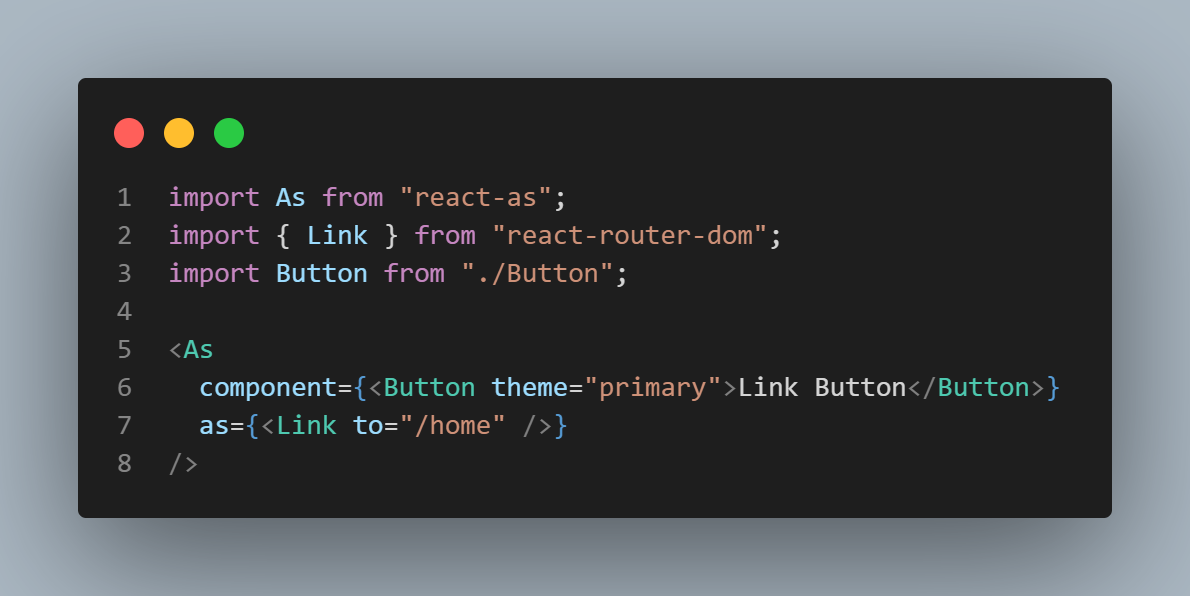react-as v1.0.3

Why?
While developing with react I've experienced the need to adjust the tag or element type of my components. This was especially needed if I wanted the appearance of one component but the functionality of an other. Like rendering a Link as a Button, the link should have the functionality (and markup) of the Link component but the appearance of the Button component.
How was this solved until now?
The solution was to introduce an component, tag or as property to the components which had the appearance but not the functionality. In the Link and Button example the Button would receive such an property. Many popular libraries are doing like this: MUI, Ant Design, react-bootstrap. The problem is that if more components should receive the functionality of the Link component, the property needs to be re-implement over and over again for each component. And this is where react-as comes in! Not only can react-as replicate the current solution without re-implementing it over and over again, its also possible to give the Link component the as prop instead of the Button.
Usage
The package comes with the As react component and the transform function. Both are exactly the same, but you can choose when to use what.
import As, { transform } from "react-as";
import { Link } from "react-router-dom";
import Button from "./Button";
// with <As /> component
const MyComponent = () => (
<As
component={<Button theme="primary">Button</Button>}
as={<Link to="/home" />}
/>
);
// with transform function
const MyComponent = () =>
transform(<Button theme="primary">Button</Button>, <Link to="/home" />);How does it work?
JSX elements have a type called ElementType or ComponentType. This type is required and is always defined. This type can be split into 3 categories:
1. intrinsic type for elements like div, p, a etc.
2. exotic type for special react elements like Fragment, Context, Memo etc.
3. custom type for your own Components
Simply put the library traverses the root elements of your components until it encounters a intrinsic element, because this means this is the element which most likely should be transformed. It creates a new custom render function where it changes the type of this element to your desired as component type.
If during the traversal no intrinsic element type could be found, the transformation is considered unsuccessful and you can decide with the strategy option how to handle the case.
API
As already mentioned, the package has two main functions:
1. The As react component. (default and named export)
2. The transform function. (named export only)
Both are doing exactly the same. The As component is just a wrapper for the transform function.
As Component Props
All props are optional and can be null or undefined as well.
Options
The options object gives you more control of the transformation process.
OverwriteProps
This functions allows you to control which properties are passed to the transformed component.
The function takes the componentProps as its first argument, the "as" component props as its second argument and should return an tuple which represents the overwritten props.
The simplified typescript type declaration is:
type OverwriteProps<CompProps, AsProps> = (
compProps: CompProps,
asProps: AsProps
) => [CompProps, AsProps];Types
The package comes with the InputComponentProps helper type which is here to help you write a correctly typed OverwriteProps function. Because typescript can't interfere the type of a JSX.Element you have to do it yourself, For all other cases the OverwriteProps can interfere the correct props type for you automatically.
import As, { InputComponentProps } from 'react-as';
<As
component={<div>Div as Paragraph</div>}
as={<MyComponent />}
options={{
overwriteProps: (componentProps: InputComponentProps<'div'>, asProps: InputComponentProps<typeof MyComponent>) => [componentProps, asProps],
}}
/>In the example above I'm using the InputComponentProps helper type to get the correct props type for the two components I'm transforming.
License
MIT